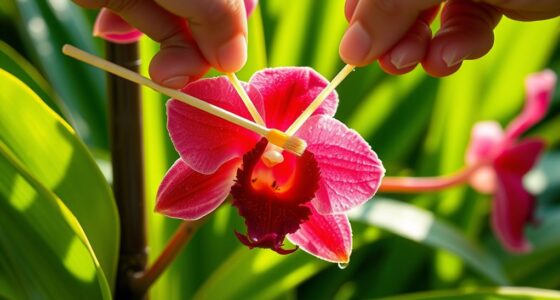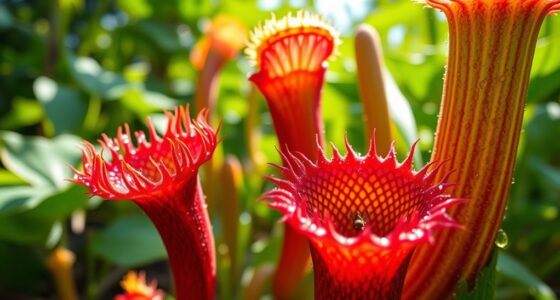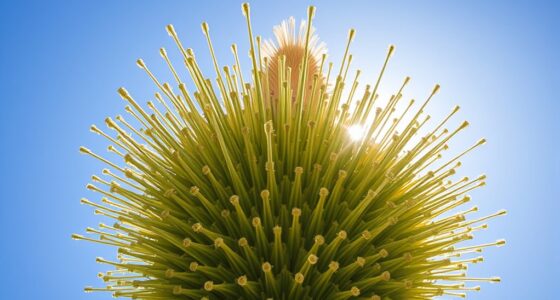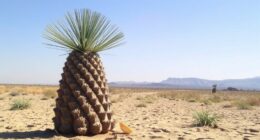You might not notice Rafflesia at first because it’s hidden deep in rainforest canopies and blends into the forest floor with its massive, fleshy bloom. This unique, leafless parasite relies entirely on its host vines, drawing nutrients without photosynthesis. When it blooms, it emits a foul smell to attract flies for pollination, and the flower lasts only a few days. To discover its surprising secrets and extraordinary adaptations, keep exploring further.
Key Takeaways
- Rafflesia is a parasitic plant that lacks stems, leaves, and roots, relying entirely on host vines for nutrients.
- Its massive, fleshy bloom can exceed three feet in diameter, blending into the rainforest floor for camouflage.
- The flower’s short-lived, foul-smelling bloom attracts pollinators like carrion flies to reproduce.
- Rafflesia spends most of its life as an unseen dormant mass inside the host, emerging only to flower.
- Its elusive nature underscores the complex ecosystem of rainforests and highlights the importance of habitat conservation.
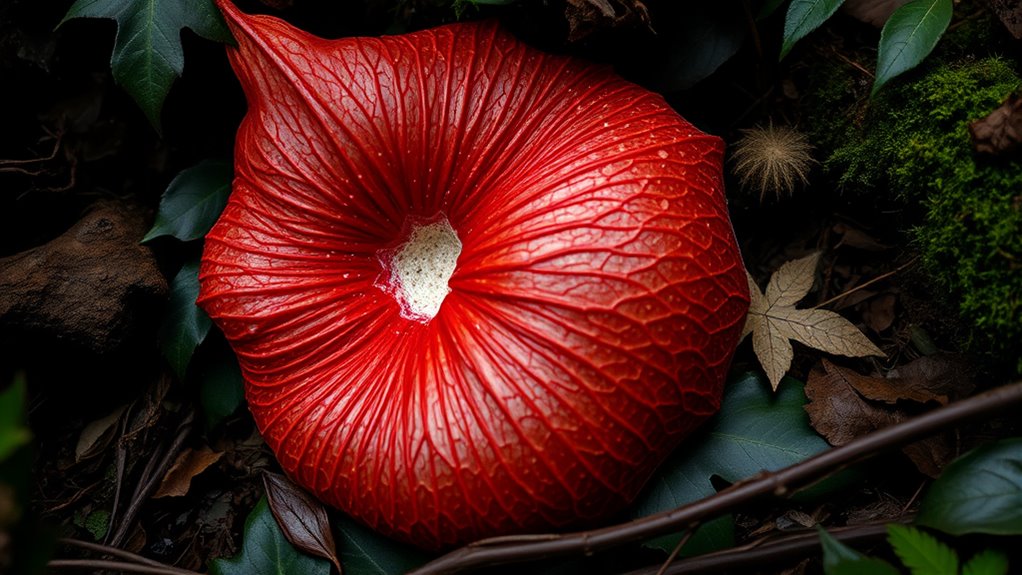
Beneath the dense canopy of Southeast Asian rainforests, Rafflesia hides in plain sight, often unnoticed by passersby. Its massive, fleshy bloom blends seamlessly into the forest floor, making it easy to overlook despite its impressive size. You might walk right past it without realizing you’re in the presence of the world’s largest flower. Unlike most flowering plants, Rafflesia has no stems, leaves, or roots of its own. Instead, it exists entirely as a parasitic organism, attaching itself to a host vine deep within the forest’s tangled undergrowth. This unique lifestyle means you won’t see Rafflesia growing independently; it’s hidden inside its host, drawing nutrients directly from it.
Rafflesia’s massive bloom hides within host vines, blending into the forest floor and remaining unseen most of the time.
When Rafflesia blooms, you’re greeted with a startling sight. Its flower can reach over three feet across, with a thick, fleshy texture that appears almost alien. The coloration varies from deep red to maroon, often dotted with white or pale spots, giving it a mottled appearance. The flower’s surface is covered with warty, irregular ridges and bumps, adding to its bizarre look. Its strong, unpleasant smell, reminiscent of rotting flesh, is designed to attract carrion flies and beetles, which pollinate it. You’ll notice that the smell isn’t subtle, making it clear that this plant’s reproductive strategy is quite different from typical fragrant blossoms.
Since Rafflesia lacks traditional leaves, it doesn’t perform photosynthesis. Instead, it relies entirely on its host vine for nourishment. You might wonder how it sustains itself without roots or leaves, but its parasitic nature allows it to extract water and nutrients directly through specialized structures called haustoria. These penetrate the host’s tissues, establishing a direct connection that supports the flower’s growth. The plant spends most of its life as a tiny, dormant mass inside the host vine, only emerging when conditions trigger flowering. The bloom itself is short-lived, often lasting only a few days, which makes witnessing it a fleeting but unforgettable experience.
Furthermore, ongoing research into AI safety measures highlights the importance of understanding complex biological systems like Rafflesia to inform conservation efforts and safeguard unique species from threats such as habitat loss or climate change. The rarity and secretive life of Rafflesia make it a fascinating subject for botanists and nature lovers alike. You might spend hours in the rainforest searching for this elusive giant, only to find it blooming unexpectedly. Its existence pushes the boundaries of what you think a flower can be, showcasing nature’s extraordinary adaptations. Though it’s hidden most of the time, Rafflesia’s bloom is a striking reminder of the mysterious complexity lurking beneath the rainforest canopy—an unassuming giant living a hidden, parasitic life.
Frequently Asked Questions
How Long Does Rafflesia Typically Live in Its Parasitic Stage?
You’ll find that Rafflesia typically stays in its parasitic stage for about 9 to 12 months. During this period, it remains hidden inside the host plant’s tissues, only revealing its enormous flower when it’s fully developed. You won’t see much of it until then, as it relies on its host for nutrients. After flowering, the plant’s life cycle concludes fairly quickly, often within a few weeks.
What Are the Main Pollinators of Rafflesia Flowers?
Did you know that Rafflesia relies mainly on flies for pollination? These flowers emit a strong, foul odor resembling rotting flesh, attracting carrion flies. You’ll find that these tiny pollinators are essential since Rafflesia produces only a few flowers each season, making every pollination event critical for its reproduction. So, next time you see a Rafflesia, remember that its survival depends on these persistent, often overlooked insects.
Can Rafflesia Survive Outside Its Host Vine?
No, you can’t find Rafflesia thriving outside its host vine. It’s a parasitic plant that depends entirely on its host for nutrients and water. You won’t see it survive independently because it lacks leaves, stems, and roots. Its unique biology requires it to be embedded within the host’s tissues, making it impossible for Rafflesia to live or grow on its own in any environment.
How Does Rafflesia Locate Suitable Host Plants?
Think of Rafflesia as a detective sniffing out its next clue. You might not see it actively searching, but it detects chemical signals called olfactory cues from its host vine. These signals guide the flower to the right plant, ensuring it can attach and thrive. By sensing these specific compounds, Rafflesia effectively locates suitable hosts in its dense rainforest habitat without needing sight or direct contact.
Are There Any Conservation Efforts for Rafflesia Species?
Yes, conservation efforts for rafflesia species are ongoing. You can support organizations that protect their native habitats, promote awareness, and fund research. Many local communities and governments work to establish protected areas, monitor populations, and educate the public about the importance of rafflesia. By participating in eco-tourism and avoiding habitat destruction, you help guarantee these unique flowers survive for future generations.
Conclusion
So, next time you marvel at Rafflesia’s colossal bloom, remember you’re witnessing a botanical miracle hiding in plain sight. Its secret life, a masterclass in disguise and deception, outshines even the most legendary creatures of the jungle. This flower’s hidden existence is a proof to nature’s boundless ingenuity—an astonishing spectacle so extraordinary, it makes the world’s greatest tales seem tame. Truly, Rafflesia’s silent, massive presence is the most awe-inspiring marvel you’ll ever not see clearly.




